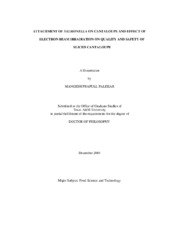| dc.contributor.advisor | Castillo, Alejando | |
| dc.creator | Palekar, Mangesh Prafull | |
| dc.date.accessioned | 2006-04-12T16:05:47Z | |
| dc.date.available | 2006-04-12T16:05:47Z | |
| dc.date.created | 2004-12 | |
| dc.date.issued | 2006-04-12 | |
| dc.identifier.uri | https://hdl.handle.net/1969.1/3285 | |
| dc.description.abstract | Increase in consumption of fresh produce over the past decade has resulted in a
rise in incidents of foodborne outbreaks due to pathogens. Chemical sanitizers have been
extensively used in the industry for decontamination of fresh produce. However, they are
ineffective in certain commodities and under certain processing conditions, necessitating
the evaluation of alternative technologies. Electron beam irradiated sliced cantaloupe
were tested for 21 days of storage for total aerobic bacterial counts, texture, color and
sensory parameters as a function of irradiation doses 0, 0.7 and 1.4 kGy and the wash
treatments, water and 200 mg/L chlorine applied to the melons before cutting. Melons
washed only with water prior to cutting had total aerobic bacterial counts of 4.0, 2.0 and
0.8 log cfu/g on day 0 at irradiation doses of 0, 0.7 and 1.4 kGy respectively. On day 0,
melons washed with chlorine prior to cutting had total aerobic bacterial counts of 2.7,
and 0.7 log cfu/g at irradiation doses of 0 and 0.7 kGy and below detection limit at 1.4
kGy. Texture measured as compression force was lower only for cantaloupe irradiated at
1.4 kGy. Irradiation did not affect objective color and descriptive attribute flavor and
texture sensory attributes of cantaloupe. Irradiation reduced Salmonella Poona by 1.1 log
cfu/g at 0.7 kGy and 3.6 log cfu/g at 1.5 kGy. The D-value of S. Poona on irradiated
sliced cantaloupe was found to be 0.211 kGy. Among the spoilage organisms, lactic acid
bacteria and mold were reduced effectively by irradiation but there was no significant
effect on reduction of yeasts. Our results show that electron beam irradiation in
combination with chemical sanitizers is effective in decontamination of fresh-cut
produce. Electron microscopy images provided valuable information on attachment sites
of S. Poona on cantaloupe rind. The ineffectiveness of chemical sanitizers due to
possible inaccessibility to pathogens in these attachment sites provides the basis for
application of irradiation in decontamination of fresh produce. | en |
| dc.format.extent | 4276369 bytes | en |
| dc.format.medium | electronic | en |
| dc.format.mimetype | application/pdf | |
| dc.language.iso | en_US | |
| dc.publisher | Texas A&M University | |
| dc.subject | Salmonella | en |
| dc.subject | Electron beam irradiation | en |
| dc.subject | Cantaloupe | en |
| dc.subject | Sensory analysis | en |
| dc.subject | Electron microscopy | en |
| dc.title | Attachment of Salmonella on cantaloupe and effect of electron beam irradiation on quality and safety of sliced cantaloupe | en |
| dc.type | Book | en |
| dc.type | Thesis | en |
| thesis.degree.department | Animal Science | en |
| thesis.degree.discipline | Food Science and Technology | en |
| thesis.degree.grantor | Texas A&M University | en |
| thesis.degree.name | Doctor of Philosophy | en |
| thesis.degree.level | Doctoral | en |
| dc.contributor.committeeMember | Acuff, Gary | |
| dc.contributor.committeeMember | Russell, Leon H., Jr. | |
| dc.contributor.committeeMember | Cisneros-Zevallos, Luis | |
| dc.type.genre | Electronic Dissertation | en |
| dc.type.material | text | en |
| dc.format.digitalOrigin | born digital | en |


